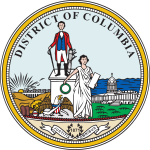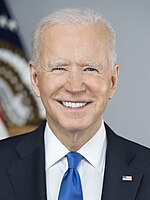
Back 2020년 미국 대통령 선거 워싱턴 D.C. Korean Выборы президента США в округе Колумбия (2020) Russian 2020 United States presidential election in the District of Columbia SIMPLE 2020年美国总统选举哥伦比亚特区选情 Chinese
| ||||||||||||||||||||||||||
| Turnout | 66.9%[1] | |||||||||||||||||||||||||
|---|---|---|---|---|---|---|---|---|---|---|---|---|---|---|---|---|---|---|---|---|---|---|---|---|---|---|
| ||||||||||||||||||||||||||
Biden 70–80% 80–90% 90–100%
| ||||||||||||||||||||||||||
| ||||||||||||||||||||||||||
| Elections in the District of Columbia |
|---|
 |
The District of Columbia participated in the 2020 United States presidential election with the other 50 states on Tuesday, November 3.[2] District of Columbia voters chose electors to represent them in the Electoral College via a popular vote, pitting the Republican Party's nominee, incumbent President Donald Trump, and running mate Vice President Mike Pence against Democratic Party nominee, former Vice President Joe Biden, and his running mate California Senator Kamala Harris. The District of Columbia has three electoral votes in the Electoral College.[3] Prior to the election, Biden was considered to be all but certain to win D.C.
The nation's capital is overwhelmingly Democratic and has voted for the Democratic nominee by massive margins in every presidential election it has participated in, ever since it was first granted electors by the passage of the Twenty-third Amendment in 1961. Biden's 86.75-point margin of victory was virtually identical to that secured by Hillary Clinton in 2016.[4] Nevertheless, the District shifted by 0.02% to the right compared with the previous election, likely due to a decline in third-party voting, making Biden the first non-incumbent Democrat since 1988 to win D.C. by a smaller margin than in the previous cycle. Along with six states,[a] it was one of seven jurisdictions where Trump improved on his 2016 margins.
- ^ "General Election 2020 - Certified Results". D.C. Board of Elections.
- ^ Kelly, Ben (August 13, 2018). "US elections key dates: When are the 2018 midterms and the 2020 presidential campaign?". The Independent. Archived from the original on January 4, 2019. Retrieved January 3, 2019.
- ^ "Distribution of Electoral Votes". National Archives and Records Administration. September 19, 2019. Retrieved November 3, 2020.
- ^ "District of Columbia Election Results". The New York Times. November 3, 2020. ISSN 0362-4331. Retrieved November 9, 2020.
Cite error: There are <ref group=lower-alpha> tags or {{efn}} templates on this page, but the references will not show without a {{reflist|group=lower-alpha}} template or {{notelist}} template (see the help page).



